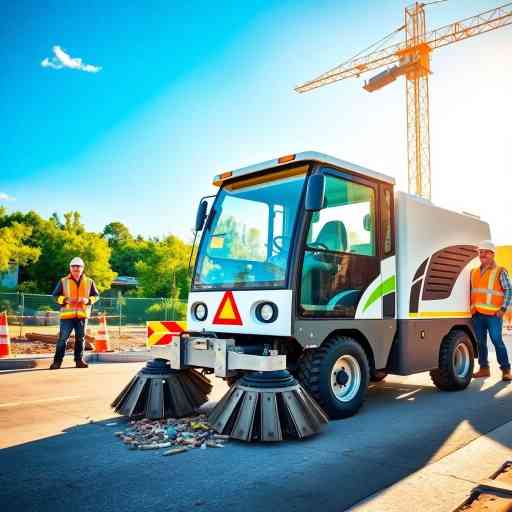Eco-Friendly Construction Street Sweeping Tips for Cleaner Sites
Explore unique eco-friendly tips for construction street sweeping, promoting cleaner job sites while minimizing environmental impact for contractors and construction teams.
Eco-Friendly Construction Street Sweeping: Unique Tips for Cleaner Job Sites
 In the bustling world of construction, cleanliness often takes a backseat to efficiency. But what if I told you that keeping your job site clean can enhance your workflow and reduce environmental impact? That's right! In this article, we dive into unique eco-friendly tips for construction street sweeping, a technique that benefits both your team and Mother Earth.
Construction sites can generate a surprising amount of dust and debris, leading to increased air pollution and unwanted runoff into nearby water bodies. Thankfully, with some thoughtful strategies and the right equipment, contractors can maintain a tidy site without sacrificing the environment. Let's explore these exciting and innovative techniques!
In the bustling world of construction, cleanliness often takes a backseat to efficiency. But what if I told you that keeping your job site clean can enhance your workflow and reduce environmental impact? That's right! In this article, we dive into unique eco-friendly tips for construction street sweeping, a technique that benefits both your team and Mother Earth.
Construction sites can generate a surprising amount of dust and debris, leading to increased air pollution and unwanted runoff into nearby water bodies. Thankfully, with some thoughtful strategies and the right equipment, contractors can maintain a tidy site without sacrificing the environment. Let's explore these exciting and innovative techniques!
Target Group: Construction Companies and Contractors
This article targets construction companies and contractors looking to elevate their sustainability efforts. Whether you're a small general contractor or part of a large construction firm, these tips can help create cleaner work sites that benefit your team and the local community. It’s not just about keeping the area presentable; it’s about implementing best practices that enhance your reputation and show commitment to eco-friendly construction.Understanding the Need for Eco-Friendly Street Sweeping
Construction street sweeping typically involves the use of mechanical street sweepers, which can be incredibly effective but may not always consider their impact on the environment. In the past, street sweeping meant generating excessive dust or relying on water that could contribute to erosion and muddy areas on your site. By using innovative eco-friendly techniques, contractors can effectively keep their sites clean and minimize their environmental footprint.Unique Techniques for Effective Street Sweeping
Here are some exciting and unique methods to improve your construction street sweeping operations:1. Invest in Smart Sweeper Technology
Modern mechanical sweepers come equipped with smart technology that enhances efficiency. These smart sweepers utilize sensors to assess debris levels and adjust their operation accordingly, ensuring they use the least amount of energy and water while maximizing performance. The results are cleaner streets with a minimal ecological footprint.
2. Implement a Dust Control Plan
A well-thought-out dust control plan is vital for effective street sweeping. Use eco-friendly suppressants made from natural substances, such as vegetable oil, to help control dust on-site. Additionally, regularly misting your construction site with water can keep airborne particles to a minimum, which complements your sweeping efforts.
3. Schedule Regular Sweeping
Don’t wait for debris to pile up before sweeping! Implement a routine schedule that allows for frequent clean-ups. Depending on the scale of your project, sweeping every few days can prevent excessive dust from becoming a health hazard. Regular sweeping also prevents dirt and debris from being tracked off-site.
4. Promote Green Waste Management
Incorporate a green waste management strategy on your job site. By setting up designated areas for disposing of debris, contractors can ensure materials are recycled instead of simply swept away. Materials like asphalt, concrete, and wood can be sorted and reused, effectively reducing the total waste footprint of your project.
5. Encourage On-Site Employee Participation
Make cleanliness a team effort by encouraging on-site workers to take part in keeping the area tidy. Provide bins for waste and encourage employees to dispose of trash and debris properly. Not only does this promote a sense of ownership among team members, but it also builds a culture of responsibility toward maintaining an eco-friendly site.
6. Choose the Right Time to Sweep
The timing of your sweeping operations can greatly influence their effectiveness. Opt for sweeping during the early morning or late afternoon to avoid peak dust-producing activities. Sweeping when the air is still and damp (e.g., right after a light rain) can help minimize dust, making the operation more effective and sustainable.
7. Utilize Low-Impact Machinery
Instead of relying solely on larger machinery that consumes more energy, consider using smaller, low-impact sweeping equipment. Electric or hybrid options produce less noise and emissions, reducing your job site’s carbon footprint. They can also access tight spaces that larger sweepers may not fit into.
8. Educate and Train Your Team
Investing in training your staff about the importance of eco-friendly street sweeping is essential. Conduct workshops that focus on sustainable practices and innovative technologies that can enhance cleaning efforts. Knowledge is power, and an informed crew is more likely to engage with eco-friendly practices actively.
The Purpose: Why Eco-Friendly Sweeping Matters
Why go through the trouble of implementing eco-friendly construction street sweeping techniques? For one, it's a crucial step towards achieving corporate sustainability goals, which is increasingly important in today’s world. Second, cleaner job sites promote health and safety among workers, reducing the risk of respiratory issues related to dust inhalation. Additionally, local communities will appreciate the reduced impact of construction projects on their surroundings, enhancing the contractor's reputation.Conclusion
In summary, eco-friendly construction street sweeping isn’t just a trend; it’s an essential part of responsible construction practices. By adopting unique techniques, investing in innovative technology, and fostering a culture of sustainability within your team, your job site can shine for all the right reasons. Clean sites, healthy environments, and a commitment to reducing environmental impacts all contribute to a better construction industry and planet. Let’s work together to keep our communities clean, one street at a time!
Transforming Construction Sites with Smart Sweeping Techniques
Explore innovative street sweeping techniques for construction sites, aimed at enhancing safety and efficiency while reducing environmental impact.

Eco-Friendly Construction Street Sweeping Tips for Cleaner Sites
Explore unique eco-friendly tips for construction street sweeping, promoting cleaner job sites while minimizing environmental impact for contractors and construction teams.

Revolutionize Construction Site Cleanliness with Eco-Friendly Street Sweepers
Discover how eco-friendly street sweepers are changing the construction landscape for contractors and the environment.